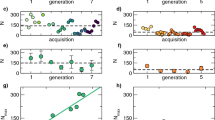Abstract
We determined the numbers of copulations and predatory attacks in swarms ofAnopheles freeborni (Diptera: Culicidae), and the distribution of these events throughout the duration of the swarming period each day. On 19 evenings of observation, we recorded 2724 copulating pairs leaving swarms and 1351 dragonfly (Pantala hymenaea andErythemis collocata) attacks. Mating activity partially coincided with predator activity. Most copulations occurred between 10 and 20 min after the swarms formed, while predation events were most frequent during the initial 15 min of the swarm. We calculated the ratio of copulations to predatory attacks during the swarming period. This ratio was significantly higher in an area sheltered by trees than it was in the open. We suggest that physiological and ecological constraints other than predation operate on the mating system of this anopheline to affect the timing of swarm initiation and swarm site selection.
Similar content being viewed by others
References
Allan JD, Flecker AS (1989) The mating biology of a mass-swarming mayfly. Anim Behav 37:361–371
Blaney WM, Schoonhoven LM, Simmonds MSJ (1986) Sensitivity variations in insect chemoreceptors: a review. Experientia 42:13–19
Bouskila A, Blumstein DT (1992) Rules of thumb for predation hazard assessment-predictions from a dynamic model. Amer Nat 139:161–176
Charlwood JD, Jones MDR (1980) Mating in the mosquitoAnopheles gambiae s.l. II. Swarming behaviour. Physiol Entomol 5:315–320
Cooter RJ (1989) Swarm flight behavior in flies and locusts. In: Goldsworthy GJ, Wheeler CH (eds.) Insect Flight. CRC Press, Boca Raton Florida, pp. 165–203
Corbet PS (1963) A biology of dragonflies. H.F. and G. Witherby Ltd. London
Downes JA (1969) The swarming and mating flight of Diptera. Annu Rev Entomol 14:271–298
Ende CN von (1993) Repeated-measures analysis: Growth and other time-dependent measures. In: Scheiner S, Gurevitch J (eds) The design and analysis of experiments. Chapman and Hall, New-York
Flecker AS, Allan JD, McClintock NL (1988) Male body size and mating success in swarms of the mayflyEpeorus longimanus. Holarc Ecol 11:280–285
Foster WA, Treherne JE (1981) Evidence for the dilution effect in the selfish herd from fish predation on a marine insect. Nature 293:466–467
Gibson G (1985) Swarming behavior of the mosquitoCulex pipiens quinquefasciatus: a quantitative analysis. Physiol Entomol 10:283–296
Harwood RF (1964) Physiological factors associated with male swarming of the mosquitoCulex tarsalis Coq. Mosq. News 24:320–325
Krebs JR, Davies NB (1987) An introduction to behavioral ecology. 2nd. Sinauer Associates, Sunderland
Marchand RP (1984) Field observations on swarming and mating inAnopheles gambiae mosquitoes in Tanzania. Neth J Zool 34:367–387
McLachlan A, Neems R (1989) An alternative mating system in small male insects. Ecol Entomol 14:85–91
Neems RM, Lazarus J, Mclachlan AJ (1992) Swarming behavior in male chironomid midges: a cost-benefit analysis. Behav Ecol 3:285–290
Neems RM, McLachlan AJ, Chambers R (1990) Body size and lifetime mating success of male midges (Diptera: Chironomidae). Anim Behav 40: 648–652
Nielsen ET, Greve H (1950) Studies on the swarming habits of mosquitoes and other Nematocera. Bull Ent Res 41:227–258
Nielsen ET, Haeger JS (1960) Swarming and mating in mosquitoes. Miscell Publ Entomol Soc Am 1:72–95
Nielsen HT, Nielsen ET (1962) Swarming of mosquitoes, laboratory experiments under controlled conditions. Entomol Exp Appl 5:14–32
O'Brien RG, Kaiser MK (1985) MANOVA method for analyzing repeated measures designs: an extensive primer. Psychol Bull 97:316–333
Parker GA (1978) The evolution of competitive mate searching. Annu Rev Entomol 23:176–196
Petersson E (1989) Age-associated male mating success in three swarming caddis fly species (Trichoptera: Leptoceridae). Ecol Entomol 14:335–340
Petersson E (1990) Male age, copulation duration and insemination success inMystacides azurea (Leptoceridae, Trichoptera). Ethology 85:156–162
Reisen WK, Asman Y, Siddiqui TF (1977) Observations on swarming and mating of some Pakistan mosquitoes in nature. Ann Entomol Soc Am 70:988–995
Rowland M (1989) Changes in the circadian flight activity of the mosquitoAnopheles stephensi associated with insemination, blood-feeding, oviposition and nocturnal light intensity. Physiol Entomol 14:77–84
Samways MJ, Caldwell P (1989) Flight behavior and mass feeding swarms ofPantala flavescens (Fabricius) (Odonata: Anisoptera: Libellulidae). J Ent Soc Sth Afr 52:326–327
Sih A (1992) Prey uncertainty and the balancing of antipredator and feeding needs. Am Nat 139:1052–1069
Sullivan RT (1981) Insect swarming and mating. Florida Entomologist 64:44–65
Svensson BG, Petersson E (1992) Why insects swarm: testing the models for lek mating systems onEmpis borealis females. Behav Ecol Sociobiol 31:253–261
Thornhill R (1980) Sexual selection within mating swarms of the lovebug,Plecia neartica (Diptera: Bibionidae). Anim Behav 28:405–412
Thornhill R, Alcock J (1983) The evolution of insect mating systems. Harvard University Press Cambridge
Wharton RH (1953) The habits of adult mosquitoes in Malaya. IV. Swarming of anophelines in nature. Ann Trop Med Parasitol 47:285–290
Wrona FJ, Dixon WJ (1991) Group size and predation risk: a field analysis of encounter and dilution effects. Am Nat 137:186–201
Yuval B, Wekesa W, Washino RK (1993) Effect of body size on swarming behavior and mating success of maleAnopheles freeborni (Diptera: Culicidae). J Insect Behav 6:333–342
Author information
Authors and Affiliations
Rights and permissions
About this article
Cite this article
Yuval, B., Bouskila, A. Temporal dynamics of mating and predation in mosquito swarms. Oecologia 95, 65–69 (1993). https://doi.org/10.1007/BF00649508
Received:
Accepted:
Issue Date:
DOI: https://doi.org/10.1007/BF00649508




